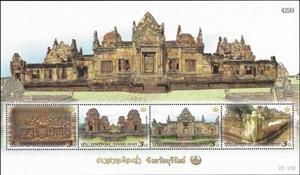Souvenir Sheet: Wat Prasat Mueang Tam (4-digit control number) (Thailand 2011)
Wat Prasat Mueang Tam (4-digit control number) (Thailand 2011)
02 April (Thailand ) within release Heritage Conservation Day 2011 - Historic Buddhism goes into circulation Souvenir Sheet Wat Prasat Mueang Tam (4-digit control number) face value 4*3 Thai baht
Souvenir Sheet is horizontal format.
Footnoted in: MichelAlso in the issue Heritage Conservation Day 2011 - Historic Buddhism:
- Souvenir Sheet - Souvenir Sheet face value 4*3;
- Souvenir Sheet - Wat Prasat Mueang Tam (4-digit control number) face value 4*3;
Souvenir Sheet Wat Prasat Mueang Tam (4-digit control number) it reflects the thematic directions:
Archaeology or archeology[a] is the study of human activity through the recovery and analysis of material culture. The archaeological record consists of artifacts, architecture, biofacts or ecofacts, sites, and cultural landscapes. Archaeology can be considered both a social science and a branch of the humanities. It is usually considered an independent academic discipline, but may also be classified as part of anthropology (in North America – the four-field approach), history or geography
Buddhism, also known as Buddhadharma and Dharmavinaya, is an Indian religion based on teachings attributed to the Buddha, a wandering teacher who lived in the 6th or 5th century BCE. It is the world's fourth-largest religion, with about 320 million followers, known as Buddhists, who comprise four percent of the global population. It arose in the eastern Gangetic plain as a śramaṇa movement in the 5th century BCE, and gradually spread throughout much of Asia. Buddhism has subsequently played a major role in Asian culture and spirituality, eventually spreading to the West in the 20th century
A temple (from the Latin word templum) is a building reserved for religious or spiritual rituals and activities such as prayer and sacrifice. It is typically used for such buildings belonging to all faiths where a more specific term such as church, mosque or synagogue is not generally used in English. These include Hinduism, Buddhism, and Jainism among religions with many modern followers, as well as other ancient religions such as Ancient Egyptian religion.



